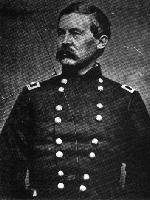"Down this way, boys"
JOHN BUFORD AND THE GETTYSBURG CAMPAIGN
 Click to enlarge
Click to enlargeBig. Gen. John Buford
National Archives
"Down this way, boys"
 Click to enlarge
Click to enlargeHistorically, theorists have held that the Battle of Gettysburg was the result of happenstance, that two foes blundered together there.1 However, this theory ignores the strategic importance of the town. Ten roads converged in the town, and it was a rail terminus. Because of this extensive road network, the town took on significance as a concentration point for Robert E. Lee's far-flung army once he became aware that the Army of the Potomac was north of the Potomac River and closing in on him. If Lee had occupied Gettysburg before the arrival of the Union army, the complexion of the campaign might have changed. Certainly, the nature of the battle which was ultimately fought would have been different, and the outcome may very well have been different. What factor had caused the town to take on such importance?
The answer to this question has been the subject of reams of paper. However, there is a simple answer to this question. The decision to stand and fight at Gettysburg was made by Brig. Gen. John Buford. By choosing to conduct a defense in depth on the ridges to the north and west of the town, Buford enabled the Army of the Potomac to occupy the strategically critical high ground around Cemetery Hill. By doing so, Buford insured that the Union would hold the strongest possible defensive position by occupying the highest and most commanding ground in the area.
Many historians have focused on this part of Buford's role in the Gettysburg Campaign, and rightly so. Few individuals contributed more to the Union victory at Gettysburg, and Buford deserved the accolades he received. A narrow focus strictly on Buford's role on July 1 does not do justice to him or his role in the campaign. Few commands of either army faced harder or more protracted fighting during the Gettysburg Campaign than his, the First Division of the Cavalry Corps of the Army of the Potomac. In order to understand fully the role John Buford played, it is necessary to examine his actions during the entire campaign.
![]() BRANDY STATION TO PENNSYLVANIA
BRANDY STATION TO PENNSYLVANIA